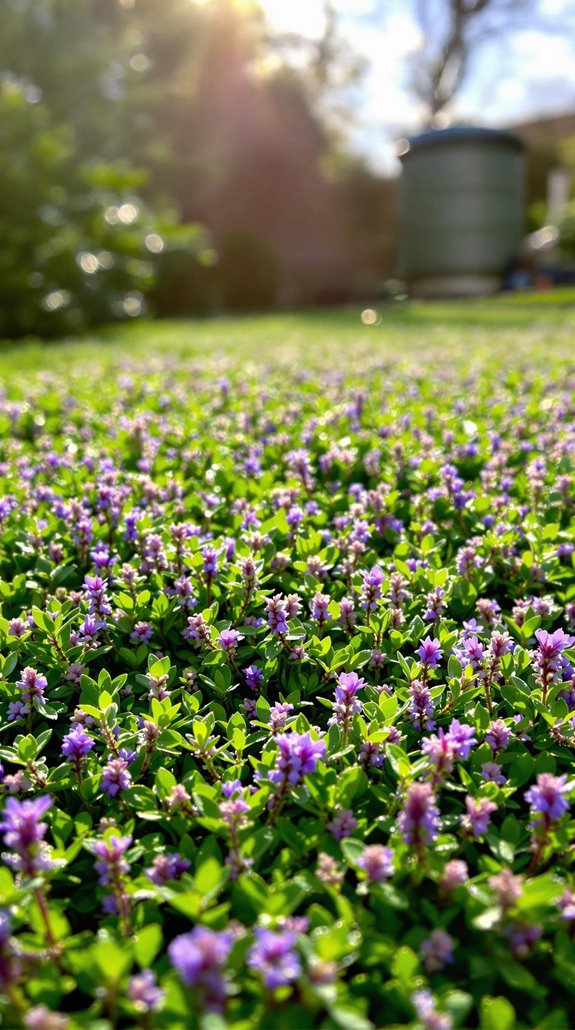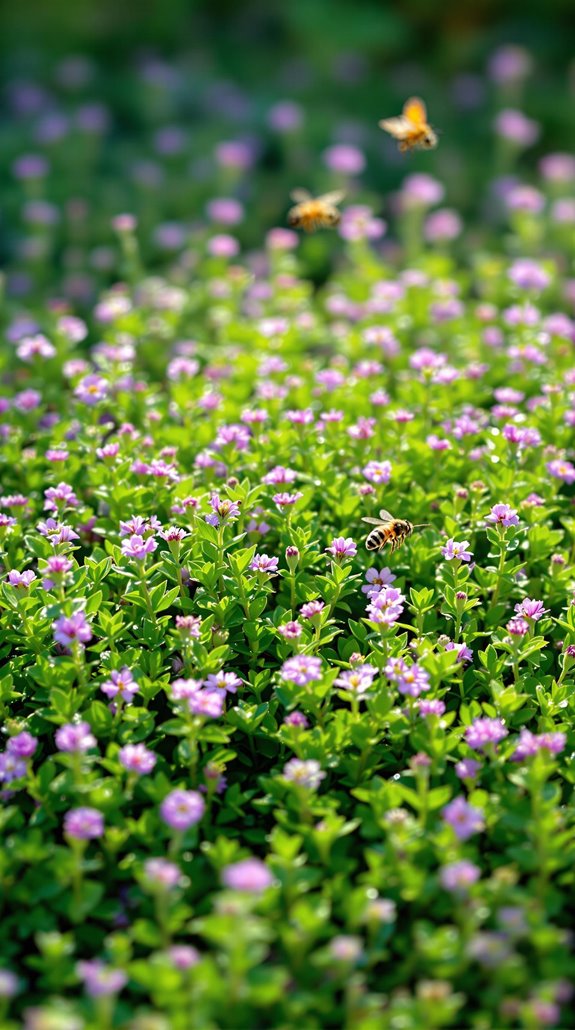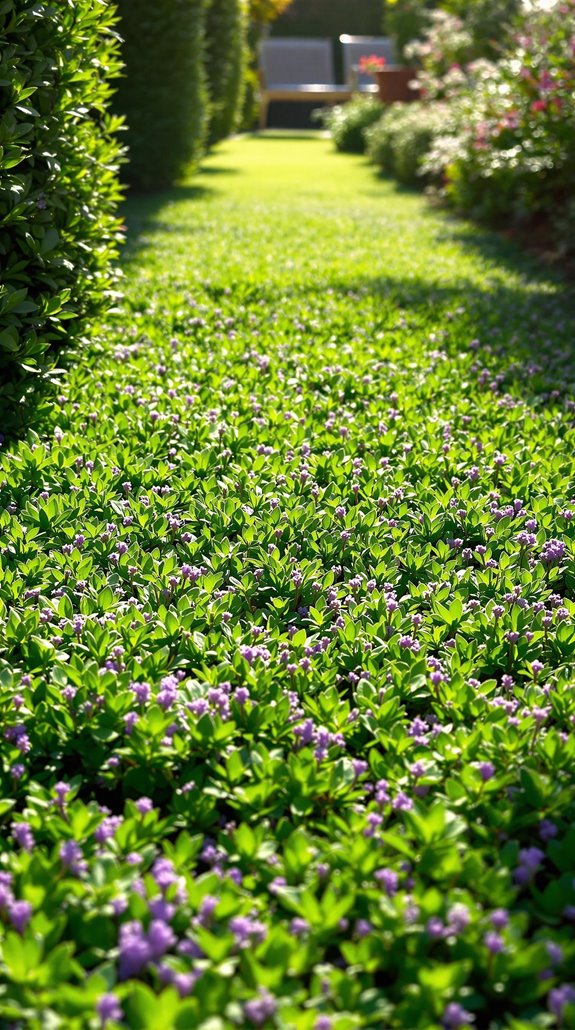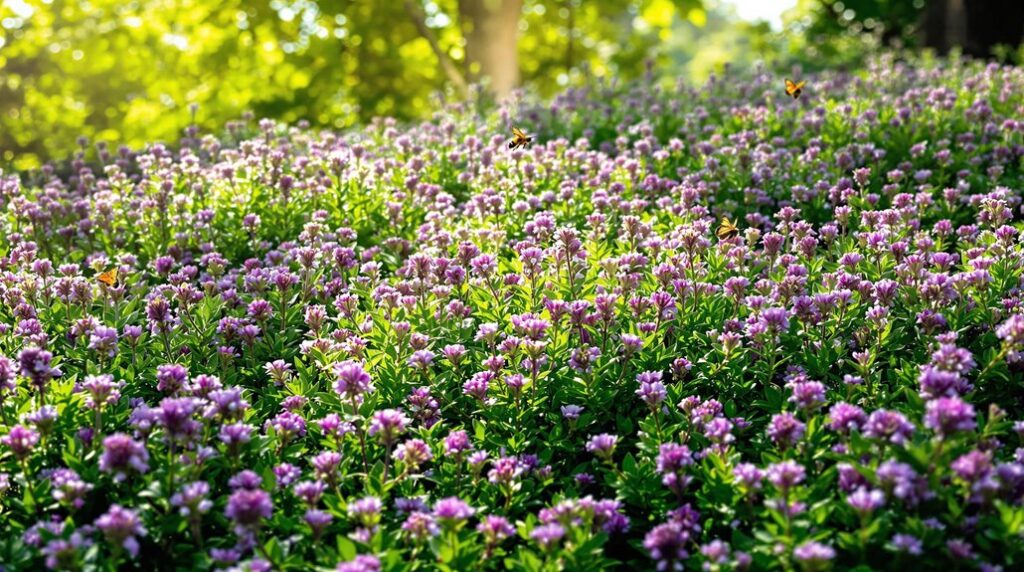I’ve been evaluating creeping thyme as a grass alternative for UK gardens, and the results challenge conventional lawn wisdom. While you’ll slash water bills and eliminate weekly mowing, there’s a significant trade-off most gardeners don’t anticipate. The installation process differs completely from seeding grass, and your family’s outdoor activities will determine whether this drought-resistant ground cover becomes your garden’s greatest asset or most frustrating limitation. Let me break down what you need to know before making this decision.
Key Takeaways
- Dramatically reduces water usage by 300+ litres monthly and eliminates weekly mowing, creating low-maintenance sustainable landscaping.
- Attracts vital pollinators like bees and butterflies while naturally repelling pests without chemical treatments.
- Thrives in poor, well-drained soils and maintains green appearance during droughts when grass turns brown.
- High installation cost of £81 per square meter with intensive initial care requirements for establishment.
- Limited to light foot traffic only, making it unsuitable for primary walkways or heavy-use garden areas.
Water-Saving Benefits for UK Climate Conditions

When considering alternatives to traditional grass lawns, creeping thyme stands out as an exceptionally water-efficient ground cover that’s particularly well-suited to the UK’s increasingly unpredictable climate patterns. I’ve found that once established after the initial three-month period, creeping thyme becomes completely drought-tolerant, requiring zero supplemental watering even during extended dry spells. This resilience is particularly important in light of the UK’s flood-proofing measures, which highlight the need for sustainable landscaping solutions that can withstand adverse weather conditions.
Unlike traditional turf that demands weekly irrigation, creeping thyme’s deep root system accesses subsoil moisture efficiently, reducing garden water consumption by over 300 litres monthly. During typical UK summer droughts when grass lawns turn brown, creeping thyme maintains its vibrant green appearance and aromatic properties. This resilience makes it an ideal choice for water-conscious gardeners seeking sustainable landscaping solutions.
The aromatic leaves of creeping thyme also provide the added benefit of naturally deterring biting insects, creating a more comfortable outdoor space during warmer months.
Maintenance Requirements Compared to Traditional Grass
Beyond the impressive water-saving advantages, creeping thyme’s maintenance profile differs dramatically from traditional grass lawns in ways that’ll reshape your gardening routine. You’ll eliminate weekly mowing entirely, since thyme’s low growth habit stays naturally compact. Once established, watering becomes minimal thanks to its drought tolerance, and you won’t need fertilizer applications that grass demands regularly.
However, the establishment phase requires more intensive care. You’ll invest considerably more upfront purchasing plants rather than seed, and regular watering during the first season is essential. Weeding becomes critical initially, though mature thyme forms a dense mat that naturally suppresses weeds. The dense root structure also helps prevent soil erosion, making it an excellent choice for sloped areas or unstable ground. While you’ll save countless hours on mowing and fertilizing long-term, expect occasional light trimming and hand-weeding to maintain ideal appearance.
Wildlife Support and Year-Round Visual Appeal

While traditional grass lawns create biological deserts, creeping thyme transforms your landscape into a thriving ecosystem that supports wildlife throughout the year. I’ve observed that thyme’s nectar-rich flowers attract essential pollinators like bees, butterflies, and hoverflies during its extended flowering period from late spring through summer. You’ll particularly appreciate how it supports rare species like the small blue butterfly here in the UK.
Beyond pollinator support, thyme’s natural pest control properties work year-round. The thymol compounds repel mosquitoes and ants while attracting beneficial predatory insects that control garden pests. The plant’s dense growth naturally chokes out weeds, reducing the need for herbicides and creating a more sustainable garden environment. Your landscape maintains visual appeal through every season with evergreen foliage that stays green during droughts when grass browns. The summer blooms cover over 90% of the foliage, creating vibrant displays in white, pink, mauve, or red.
Soil Adaptability and Pest Resistance
Unlike demanding turf grasses that require specific soil conditions, creeping thyme adapts remarkably well to challenging growing environments that would stress traditional lawns. I’ve found it thrives in sandy, rocky, or well-drained loamy soils with neutral to slightly alkaline pH levels. It actually prefers lean, low-fertility conditions over rich garden soil, making it perfect for areas where grass struggles.
What impresses me most is its natural pest resistance. The aromatic oils deter deer, rabbits, and most insects without any chemical treatments. Once established, it’s remarkably drought-tolerant and disease-resistant in well-drained conditions. You won’t need fertilizers, pesticides, or constant soil amendments. This hardy perennial eliminates replanting concerns while requiring minimal maintenance—exactly what busy gardeners want. The plant produces attractive woody stems over time, which adds structural interest to your ground cover but may eventually require replacement after several years of growth.
Traffic Tolerance and Usage Limitations

Although creeping thyme‘s hardy nature makes it an appealing grass alternative, its traffic tolerance presents significant limitations that’ll determine where you can successfully use it. I’ve found thyme withstands only light to moderate foot traffic—roughly 5-10 gentle steps per square foot daily before showing wear. Traditional turf grass consistently outperforms thyme by 2-5 times in durability.
You’ll need to avoid planting thyme in primary walkways, children’s play areas, or house-to-shed paths where heavy use occurs. Instead, I recommend slopes and ornamental beds where direct footfall is minimal. Strategic placement of stepping stones protects the plant while maintaining accessibility. When selecting your thyme variety, consider that spacing plants 8-12 inches apart allows for proper spreading and establishment in low-traffic areas.
Recovery takes 4-8 weeks under ideal conditions, and damaged areas may thin by 30-50% with regular use, requiring careful replanting.
Installation Costs and Practical Planning Considerations
Installation costs for creeping thyme lawns can shock homeowners who expect grass-like pricing. You’ll need approximately 36 plugs per square meter at £2.25 each, making materials alone cost around £81 per square meter. I can’t sugarcoat this – there’s no seed option available, forcing you into pricier plug purchases.
Your preparation expenses compound quickly. Existing lawn removal adds labor costs, while mandatory soil amendments like compost and bone meal increase material expenses. You’ll need perfect drainage and full sun exposure, potentially requiring additional site modifications.
However, I’ve found the long-term economics favor thyme lawns. You’ll eliminate weekly mowing costs, reduce water bills considerably, and skip fertilizer purchases entirely. The 2-3 year establishment period demands patience, but bi-annual maintenance versus weekly lawn care creates substantial savings over time. Once mature, the thyme becomes walkable ground cover that releases pleasant fragrance when stepped upon.
Conclusion
I’ve found creeping thyme lawns work best in UK gardens when you’re prioritizing water conservation and low maintenance over heavy use. You’ll save considerably on water bills and eliminate mowing, but don’t expect it to handle regular foot traffic like traditional grass. If you’ve got decorative areas or slopes that need ground cover, it’s excellent. However, for play areas or main pathways, stick with conventional turf.
References
- https://www.gardeningknowhow.com/lawn-care/lawn-substitutes/creeping-thyme-lawn/growing-creeping-thyme-lawns.htm
- https://www.gardenersworld.com/how-to/grow-plants/creeping-thyme-lawn/
- https://www.marthastewart.com/creeping-thyme-lawn-8549925
- https://www.thespruce.com/creeping-thyme-lawn-11710366
- https://www.planetnatural.com/thyme-lawn/
- https://gogardennow.com/blogs/news/why-you-should-plant-a-creeping-thyme-lawn-instead-of-grass
- https://stjohnsgardencentre.co.uk/herbs/how-to-grow-thyme/
- https://www.gardenersworld.com/how-to/grow-plants/creeping-thyme/
- https://www.idealhome.co.uk/garden/garden-advice/how-to-grow-a-creeping-thyme-lawn
- https://www.homesandgardens.com/gardens/reasons-to-grow-a-creeping-thyme-lawn

